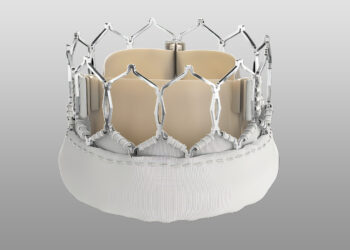[ad_1]
LOS ANGELES — Aortic mechanical valves are associated with better survival than bioprosthetic valves in patients aged 60 years or younger, showed 12-year survival data from a large surgical database.
Even though the analysis suggests that mechanical valves should be used preferentially in younger patients undergoing aortic valve surgery, the same data set shows that the already low proportion of aortic replacements performed with mechanical devices has been and remains on a steep decline, according to Michael E. Bowdish, MD, vice chair of the Department of Cardiac Surgery at the Smidt Heart Institute at Cedars-Sinai in Los Angeles.
Given these data and this contrary trend, the evidence of a survival advantage for mechanical valves in relatively young patients “should make us pause,” according to Bowdish, whose findings were presented during a latebreaker session at the Society of Thoracic Surgeons (STS) Annual Meeting in Los Angeles and published simultaneously in the Journal of the American College of Cardiology.
The analysis used data from the STS Adult Cardiac Surgery Database, which captures 97% of all adult cardiac surgeries performed in the United States. Outcomes were further adjudicated by linking them to death certificates obtained from the National Death Index.
Database Captures 97% of All Cardiac Surgeries
The study identified 109,842 patients aged 40-75 years in the STS database who underwent surgical aortic valve replacement from July 2008 to March 2019. Of these, 86% received a bioprosthetic device and 14% received a mechanical prosthesis.
After a median follow-up of more than 5 years (the upper limit was 12 years), the risk-adjusted hazard ratio (aHR) for all-cause mortality was 31% lower in patients aged 40-59 years who received a mechanical valve than in those who received a bioprosthetic valve (aHR, 0.69; 95% CI, 0.59-0.79). For patients aged 50-59 years, all-cause mortality was 13% lower (aHR, 0.87; 95% CI, 0.80-0.94).
Risk-adjusted all-cause mortality did not differ significantly by valve type for patients aged 60-69 years (aHR, 0.99; 95% CI, 0.91-1.08) or 70-75 years (aHR, 1.12; 95% CI, 0.97-1.29).
The survival curves favoring mechanical values began separating about 5 years after the procedure in the youngest cohort. In patients aged 50-59 years, the separation between the curves became visible at about 8 years.
Durability of Mechanical Aortic Valve Supported
The potential durability advantage of a mechanical valve over a bioprosthetic aortic valve has been predicted, but previous studies have produced mixed results, according to Bowdish. One study that used statewide data from New York concluded that there was no difference in survival or stroke in patients aged 50-59 years after propensity matching. However, in a study that used data from California, the mortality advantage of a mechanical valve in patients 45-54 years was significant (P = .03).
The STS database provided detailed information about preexisting comorbidities and procedural characteristics, so risk adjustments could be more precise. On the basis of this and the large sample size, the study provided strong evidence that “prosthesis choice had an independent effect on age-related survival,” Bowdish explained.
The requirement for oral anticoagulation with mechanical valves is one factor probably driving the preference for bioprosthetic devices, he pointed out. Although mechanical valves were already less commonly implanted at the beginning of the study period, that rate fell from 20% in 2008 to less than 10% in 2019.
The strength of this study was increased by multivariable regression, time-to-event, and sensitivity analyses. All of these “confirmed the primary findings,” Bowdish reported. For example, he and his team conducted a sensitivity analysis restricted to patients aged 54-65 years, which showed that mechanical valves confer a survival benefit on patients younger than 60 years, consistent with the study overall findings.
Current Practice at Odds With Guidelines
Despite American College of Cardiology guidelines that recommend surgically implanted valves for patients younger than 60 years (and consideration of surgical valves in patients aged 65-80 years), Bowdish cited data suggesting that up to 50% of patients 65 years of age or younger undergo transcatheter aortic valve replacement. The decline in the surgical placement of mechanical valves needs to be reexamined, given this new evidence that they are durable, at least relative to bioprosthetic valves, he said.
This last point is an important message from this trial, according to John A. Dearani, MD, director of pediatric and adult congenital heart surgery at the Mayo Clinic in Rochester, Minnesota, who was the STS-invited discussant for this latebreaker paper. There is concern that the current practice of aortic valve replacement is not within the confines of the data, he explained.
“Bowdish’s study serves as an important wake-up call, reinforcing long-established evidence that mechanical valves provide a significant survival benefit over bioprosthetic valves in young and middle-aged adults. Yet, these data have been largely ignored due to bias, marketing influence, and an aversion to anticoagulation,” he said.
The increasing preference for bioprosthetic valves is probably “fueled by enthusiasm for TAVR [transcatheter aortic valve replacement],” Dearani said, calling for a reassessment. On the basis of the new data and previous evidence “of inferior long-term durability, reintervention risks, and patient outcomes” with bioprosthetic valves, the available data should be respected, particularly with regard to the longer predicted lifespan of relatively young patients, he said.
“Moving forward, the cardiovascular community must commit to evidence-based decision-making and collaborative patient counseling to definitively address biases and guide optimal lifelong management strategies,” he said.
Bowdish reports financial relationships with Renibus Therapeutics. Dearani reports no financial disclosures.
[ad_2]
Source link : https://www.medscape.com/viewarticle/aortic-valves-surpass-prosthetics-long-term-survival-2025a10003ji?src=rss
Author :
Publish date : 2025-02-11 13:03:28
Copyright for syndicated content belongs to the linked Source.














